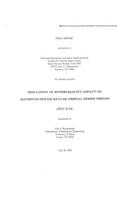
Simulation of Hypervelocity Impact on Aluminum-Nextel-Kevlar Orbital Debris Shields
Series:
An improved hybrid particle-finite element method has been developed for hypervelocity impact simulation. The method combines the general contact-impact capabilities of particle codes with the true Lagrangian kinematics of large strain finite element formulations. Unlike some alternative schemes which couple Lagrangian finite element models with smooth particle hydrodynamics, the present formulati
NaN
VOLUME
English
Paperback

An improved hybrid particle-finite element method has been developed for hypervelocity impact simulation. The method combines the general contact-impact capabilities of particle codes with the true Lagrangian kinematics of large strain finite element formulations. Unlike some alternative schemes which couple Lagrangian finite element models with smooth particle hydrodynamics, the present formulation makes no use of slidelines or penalty forces. The method has been implemented in a parallel, three dimensional computer code. Simulations of three dimensional orbital debris impact problems using this parallel hybrid particle-finite element code, show good agreement with experiment and good speedup in parallel computation. The simulations included single and multi-plate shields as well as aluminum and composite shielding materials. at an impact velocity of eleven kilometers per second.Fahrenthold, Eric P.Johnson Space CenterSIMULATION; HYPERVELOCITY IMPACT; ALUMINUM; FINITE ELEMENT METHOD; COMPUTER PROGRAMS; KEVLAR (TRADEMARK); SHIELDING; SPACE DEBRIS; COMPUTATION; HYDRODYNAMICS; IMPACT VELOCITY; LAGRANGIAN FUNCTION; METAL MATRIX COMPOSITES; PARALLEL COMPUTERS...
Price Comparison [India]
In This Series
Bestseller Manga
Trending NEWS




















